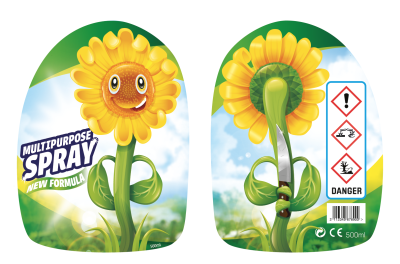Household Products Can Be Dangerous So Always Read the Back

We all use household products at home for everyday jobs like cleaning, repairs, gardening, maintenance and decorating. For example toilet and floor cleaners, detergents, paints, glues and weed killers. Most of these products aren’t dangerous if used properly. However, some need more careful handling than others. The information on the back of a product should help you identify the more dangerous ones; what the dangers are and advise you how to use chemical safely. So it is really important that you always read the back of the chemical product before you use it.
How will you know if a product is dangerous?
Household products that contain dangerous chemicals require labels on the back of the package to let you know what the potential dangers are and how to use and dispose of the product safely. A label will include
- the name of the chemical product,
- the name, address and telephone number of the supplier of the chemical product,
- pictogram(s) to help you see the potential danger,
- a signal word to alert you to the severity of the danger,
- Statements that tell you what the dangers are and what safety measures are required.
- the quantity of the package
These labelling rules changed recently, so you might notice some chemicals have old symbols while others have new pictograms but the most important thing to remember is that you must read the back before you use the chemical.
What kind of chemical dangers are there?
There are three main dangers divided into different types and degrees of danger.
- Physical: Such as flammable which means the chemical may catch fire easily
- Health: Such as irritating to skin which means the chemical might give you a rash such as dermatitis
- Environmental: Such as ozone depleting chemicals might cause long term damage to the ozone layer.
Using chemicals safely
To stay safe when using potentially dangerous chemicals in the home, always read the label and follow the instructions carefully.
In addition, with many chemicals, it’s advisable to follow these guidelines:
- only use as much as you need of a chemical
- if a chemical is dangerous, remove children, pets and their toys from the area for as long as is recommended on the label
- properly ventilate the area by opening the windows – if recommended, wear gloves, long sleeves and a mask
- don't leave chemicals unattended – if you have to leave the room in the middle of a task, put the chemical away or take it with you
- do not combine different chemicals - it’s dangerous to combine two common household cleaners, chlorine bleach and ammonia, as this forms a highly toxic gas
- after using chemicals, wash any part of you that came into direct contact with the chemical with warm soapy water
Storing and disposing of chemicals safely
Safely store chemicals by following the storage instructions on the label.
In addition, in most cases, you should:
- not move chemicals into other containers – these containers might not be capable of safely storing the chemical, you might not remember what is in the bottle and children might mistakenly think the chemical is safe to eat or drink
- keep all dangerous chemicals out of the reach of young children or locked up
- never store dangerous chemicals near food or food products
- keep dangerous chemicals away from items used to prepare and cook foods, like pots, pans and cooking utensils
If a chemical is leaking, expired or looks bad, you should dispose of it. Never pour chemicals down the drain unnecessarily – remember that your drainage ends up in seas and rivers. Instead:
- follow the advice on the label
- take it to your local civic amenity site (waste and recycling centre), who can get rid of it safely
If you have an accident with a dangerous chemical
If you or a member of your family swallow or come into contact with a potentially dangerous chemical, you must seek medical attention.
You can contact your local GP and/or contact the National Poison Information Centre at Tel: 01 809 2166 or www.poisons.ie who can provide advise or information.
For further information on chemical safety please email our chemicals helpdesk team at chemicals@hsa.ie
Further information
- http://www.clpireland.ie
- www.hsa.ie/clp
- http://www.understandthelabel.org.uk/
- http://echa.europa.eu/web/guest/chemicals-in-our-life/clp-pictograms
- HSA Information sheet for the retail sector
